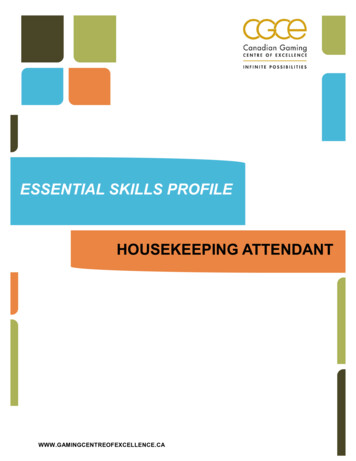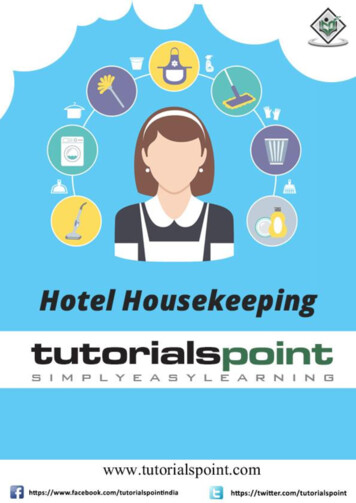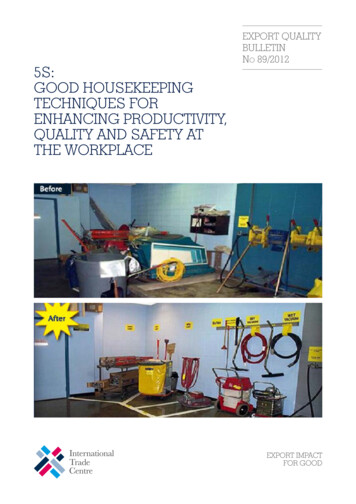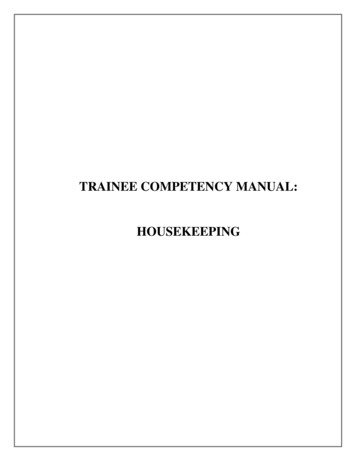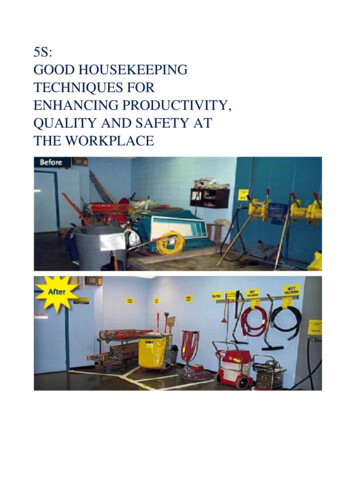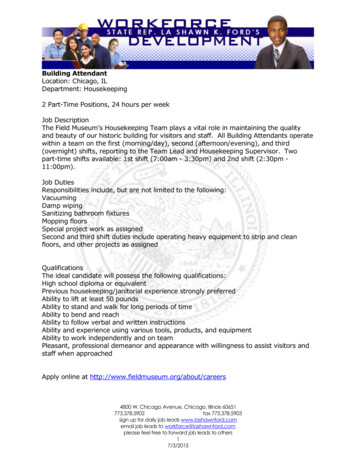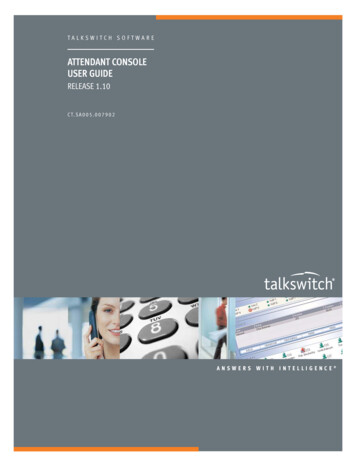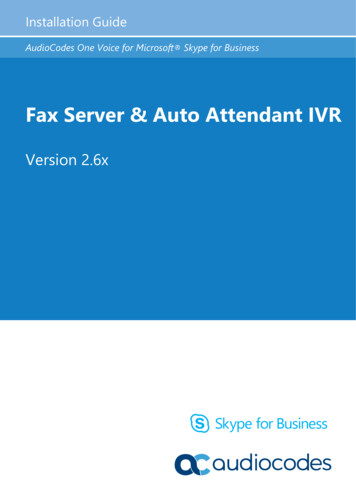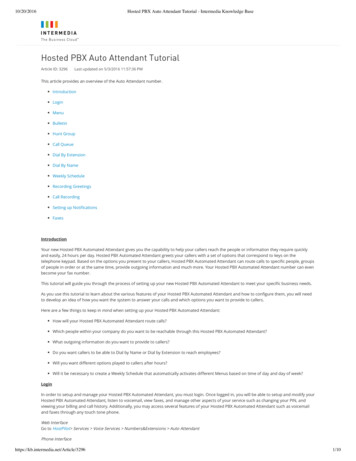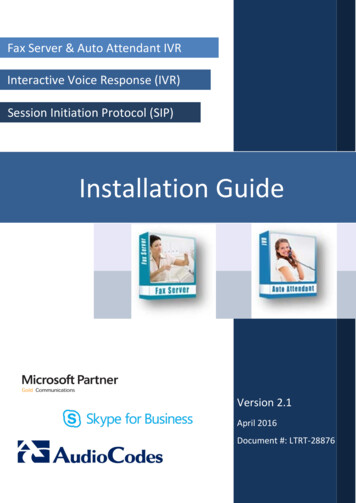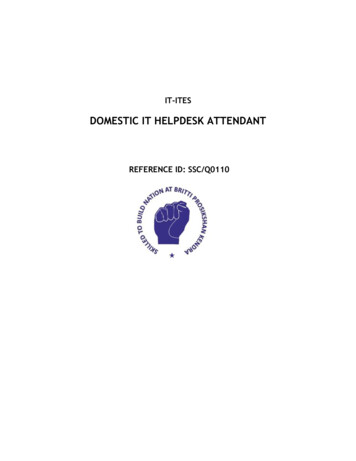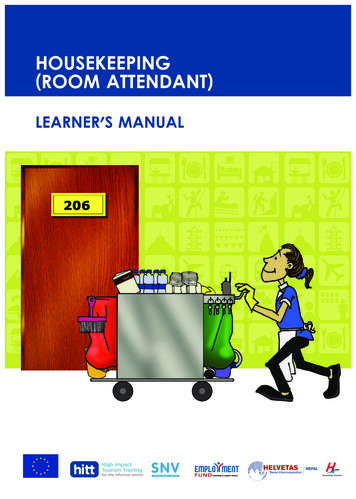
Transcription
HOUSEKEEPING(ROOM ATTENDANT)LEARNER'S MANUALF U N D investing in nepal's future
THE HITT PROGRAMMEOne of the several skill building products developed by the High Impact Tourism Training forJobs & Income programme (HITT) is the Housekeeping – Room Attendant curriculum andtraining, designed to support informal workers and potential workers from the tourism sectorof Nepal to enhance their productivity and professionalism, and increase their employabilityand income opportunities.The HITT programme is implemented by the Netherlands Development Organisation(SNV), through the financial assistance of European Commission (EC) Investing in Peopleprogramme. The HITT initiative aims to contribute to sustainable pro-poor growth of theinformal tourism sector in seven of the least-developed and developing countries inSub-Saharan Africa and Asia.Within the framework of this initiative, SNV and its local partners have elaborated a skilldevelopment programme for informal sector workers, especially women and youth,unskilled and semi-skilled workers, in close collaboration with the private sector. In Nepal,the HITT programme has been working with the tourism sector to identify occupations indemand, develop training curriculums, produce training material and deliver training toits beneficiaries. The six selected occupations include assistant cook, waiter, housekeeper,service excellence and hygiene, trekking guide, as well as homestay and lodge operators.ACKNOWLEDGEMENTSSNV would like to first thank the Employment Fund Secretariat (EFS) for coordinating amongTVET service providers to produce the training materials. We acknowledge expertise sharedby Jhapa technical institute, Global Institute of Hotel Management, Oriental Hospitality andTourism Training, Sahara School of Hospitality Management, Janahit Trading and Trainingand Lisa Gordon-Davis in the development of the training model of Housekeeping – RoomAttendant. SNV appreciates the contribution of Hospitality Solutions (HS) and Zaeem Ahmedin developing the training materials and coordinating with key stakeholders to developthe final product. Many thanks also to Monica Oliveros, Prakriti Sherchan from HITT for theirinputs. Special thanks go to Bibek Shrestha who coordinated the publication of this series ofmanuals. We would also like to express our sincere thanks to Sanjay Madnani and his teamat Umbrello Design who designed and illustrated it.ContributionsThis publication has been produced with the financial assistance of the European Union.The contents of this publication are the sole responsibility of SNV and can in no way betaken to reflect the views of the European Union. For more information on Europe Aid,please visit http://ec.europa.eu/europeaid/
MODULE 1: TOURISM, HOSPITALITY, FOOD AND BEVERAGE SERVICETable of ContentsAbout Housekeeping Room Attendant curriculum7Objective of the housekeeping Learner manual7Learning outcome of the training7Career Path8MODULE 1: HOTEL AND HOUSEKEEPING12110Introduction1.1 Introduction of Hotel1.8 Communication1.9 Guest complaints1.10 Handling Guest Complaints101010101215151818182022232628MODULE 2: PRINCIPLES AND PRACTICES OF CLEANING312321.1.1 The Organisattion of Hotels1.1.2 Staffing of the hotel1.2 Classification of hotels1.3 Different departments of the hotel1.4 The Role of the Housekeeping department1.4.1 Positions in the Housekeeping Department1.5 Housekeeping personnel1.5.1 Attributes and qualities of a house keeping personnel1.6 Dress Codes and Uniforms of house keeping1.7 Personal Hygiene1.7.1 Characteristics of Housekeeping personnel2.12.22.32.42.5IntroductionDefinition of cleaningDefinition of SoilingEquipment and MaterialsCleaning AgentsPrinciples of cleaning and cleaning procedures2.5.1 Different cleaning techniques323232343637MODULE 3: GUEST ROOMS, ROOM COMPONENTS AND KEY433443.13.23.33.4IntroductionTypes of RoomsThe components of the guest bed roomBed types and Linen requirements standardsKey and Key Control44454749
FOOD PRODUCTIONAND BEVERAGE(ASSISTANTSERVICE -COOK)LEARNER- LEARNER'SMANUAL MANUALMODULE 4: HOUSEKEEPING TROLLEY (MAID CART)MANAGEMENT, GUEST ROOM CLEANING ANDHANDOVER PROCEDURE53454Introduction4.1 Function of Housekeeping trolley (maid cart)4.2 Efficient Room Cleaning4.3 Cleaning of a Vacant Room4.4 Closing down and preparing for the next shift5456566568MODULE 5: PUBLIC AREA CLEANING735744.2.1 Sequence for Cleaning and Servicing a Guest RoomIntroduction5.1 Public Areas5.1.1 Cleaning restaurant and bar areas5.1.2 Public restrooms5.1.3 Cleaning lifts74757677MODULE 6: LAUNDRY FUNCTIONS AND LINEN MANAGEMENT79680Introductions6.1 Laundry6.1.1 Laundry Department6.2 Laundry Equipment6.2.1 Laundry process6.3 Maintaining Linen Room & Linen6.3.1 Activities of the Linen Room6.3.2 Linen Items80808081838485MODULE 7: HOUSEKEEPING SERVICES AND OTHER DUTIES87788Introduction7.1 Other guest services7.1.1 Room transfers7.1.2 Guest Requests7.1.3 Staff Requests7.1.4 Service Housekeeping requests7.1.5 Checking Room Allocations7.1.6 Room status report7.1.7 Guest Information Directory7.1.8 Room Allocations7.1.9 Assign rooms after they are cleaned7.1.10 Turndown Service7.1.11 Lost and found property888889899090909090939394
MODULE 1: TOURISM, HOSPITALITY, FOOD AND BEVERAGE SERVICE7.2 Responding to VIPs7.3 Looking after Plants7.4 Housekeeping supply management959696MODULE 8: MAINTENANCE, UNDERSTANDINGRISKS AND PREVENTIVE eporting Maintenance ProblemsSafe Work PracticesSafety in room cleaning and servicingPreventing AccidentsSafely handling cleaning agents, equipment and machineryHygiene and Safety Risks in BathroomsPrecaution against infectious diseases like HIV/AidsPersonal Safety Issues8.8.1 Procedure for Reporting Accidents8.9 First Aid8.108.118.128.138.148.9.1 Treating small common injuriesProper use of the hazard signsSafety InspectionsSecurity in HotelsPest controlFire8.14.1 Preventing fire accident in the 7108
FOOD PRODUCTIONAND BEVERAGE(ASSISTANTSERVICE -COOK)LEARNER- LEARNER'SMANUAL MANUAL
MODULE 1: TOURISM, HOSPITALITY, FOOD AND BEVERAGE SERVICEAbout the HousekeepingRoom Attendant curriculumThe Housekeeping curriculum is developed to equip people working in the hotels, lodgesand homes stays on technical and practical knowledge required in the profession.Especially for those who wish to start their carreer as a Housekeeper- Room Attendantin the hospitality sector. This curriculum gives all the necessary duties and areas of workthat the housekeeper’s duties entail; personnel hygiene/attributes, cleaning methods,rooms, housekeeping services, laundry and many more relevant topics. Any hospitalityestablishment which caters to accommodation can use this manual, and modules canbe individually selected as required. Throughout the development of the material, thecompetence of the present work force in the hospitality sector in Kathmandu valleywas considered through market needs analysis. Further input was incorporated to thedevelopment of materials and content with the help of TVET service providers working inthe hotel/accommodation sector in Nepal. This was further complimented by the industryexperts who shared their knowledge on curriculum and material development standards.Objective of the housekeeping learner manualBy the end of the training course, you will have excellent knowledge of the duties, rolesand responsibilities of a housekeeper/room attendant, reflecting high standards of work,customer service and best operational practices.Learning outcome of the trainingUpon successful completion of this course, the beneficiaries should be able to demonstrateand practice: Understanding of the service sector, accommodation and tourism Explain the role, function and organisation of the housekeeping department of ahotel; Communicate professionally and effectively with guests. Demonstrate the principles and practices of cleaning as applied to the duties of ahousekeeper/room attendant; Apply theoretical knowledge in the housekeeping operation in relation to guest roomcleaning and public area cleaning; Proper use of housekeeping equipment, agents, chemicals and handling. Provide housekeeping services to guests; Conduct other housekeeping operations as necessary, and Maintain a safe and secure working environment;7
FOOD AND BEVERAGEHOUSEKEEPING(ROOMSERVICEATTENDANT)- LEARNER- LEARNER'SMANUALMANUALTarget beneficiaries of housekeeping manualThe target beneficiaries of this course are housekeeping staff who want to gain technicaland practical skills to work in the housekeeping department.Career PathAfter completing this course, a learner will be able to: join a hotel as a housekeeping intern / assistant Work as; Linen and uniform attendant Laundry As a houseman or a trainee in housekeeping departmentAssessmentFormative AssessmentLearners may be formally assessed throughout the course. This will take place in the form ofquizzes, practical exercises and/or applications.Summative AssessmentA final summative assessment may be given to learners at the end of the course and willbe based on the learning outcomes for the course.This assessment is (indicate what format this assessment takes, for example, a paper-basedassessment, practical, simulation) to be completed at the end of the course; for practicalassessments, the practical components of the course must be combined into an integratedassessment to ensure that learners can demonstrate the entire process.National Skill Testing Board Exam (NSTB)After completion of this 390 hours course, the learners will go through NSTB/CTEVT exama paper-based written exam and practical exam. Certifications will be awarded aftersuccessful completion of exams.IconsThe following icons are used in this learner guide:8Important to rememberDid you know?DefinitionDanger / warning
MODULE 1: TOURISM, HOSPITALITY, FOOD AND BEVERAGE SERVICEMODULE 1HOTEL AND HOUSEKEEPING9
FOOD AND BEVERAGEHOUSEKEEPING(ROOMSERVICEATTENDANT)- LEARNER- LEARNER'SMANUALMANUAL1 Introduction : Hotel and HousekeepingThis module will explain how a hotel operates, and the different departments in ahotel, including the housekeeping department. Your role as a Room Attendant willbe discussed to ensure that you understand how to present and conduct yourselfprofessionally in this occupation.1.1 Introduction of HotelA Hotel is an establishment that provides accommodation and also usually meals andother services for travellers and other paying guests. It provides paid lodging, usuallyon a short-term basis. Hotels often provide a number of additional guest services suchas a restaurant, laundry, a swimming pool or childcare. Some hotels have conferenceservices and meeting rooms and encourage groups to hold conventions, functionsand meetings at their location. Hotels are found in almost all the cities of the world.Hotels operate twenty four hours a day, seven days a week. The principal factor thatdetermines the guest’s attitude towards a hotel is the quality of service, although otheramenities such as room, food and beverages are also of importance.1.1.1 The Organisation of HotelsOrganisation means the arrangement of staff and assignment of their duties andresponsibilities, so that the operation can function efficiently and as one unit. Theorganisation of the hotel will depend on its size and type. As the hotel varies in size,shape and age, so the exact role of the housekeeping department will differ from onehotel to another. However, whatever the type or size of hotel, regarding the work ofhousekeeping, the department has one basic function-to oversee the cleanliness andcomfort of the hotel.1.1.2 Staffing of the hotelAn organisation chart is a drawing that shows the relationship between departmentsor divisions and specific positions within an organisation. There is no model or standardorganisational chart that describes how all hotels should be organised. Each hotel hasdifferent charts according to their size.The plan for any particular hotel depends on a many things such as location, clientbase, and services to be offered, layout of the building, management structure, etc.However, despite such differences, there is a framework which many hotels use.1.2 Classification of hotelsGenerally hotels are classified on the types of facilities, services, number of outlets,location, target market, affiliation and ownership. The classification varies from place toplace and from country to country and usually categorized as per following criteria’s.Classification as per size in NepalSmall hotel: 1-25 roomsMedium hotels: 25-100Large hotel: 100 – above10
MODULE 1: TOURISM, EPINGSERVICEClassification as per facilities and service:2 star: minimum 1 food and beverage out let, service till 2200 hours, intercom andlimited room services, etc.3 star: minimum 2 food and beverage out lets, 1 bar, 24 hours room service, currencyexchange, postal service and elevators etc.4 star: conforming 3 star standards, more comfortable rooms, 3 restaurants including acoffee shop, mini bar, elevator, banquette, seminar, meeting facilities and parking lot,etc.5 star: conforming 4 star standards plus health club, sauna, Jacuzzi, mini-bar etc.The following is a sample organisation chart for a small hotel.GeneralManagerFood ont ations/Front Desk11
FOOD AND BEVERAGEHOUSEKEEPING(ROOMSERVICEATTENDANT)- LEARNER- LEARNER'SMANUALMANUALThe following is a sample organisation chart for a relatively large esourceDivisionMarketingand SalesDivisionFinanceDivisionFood ffRoom attancent - you !1.3 Different departments of the hotelFor
Apply theoretical knowledge in the housekeeping operation in relation to guest room cleaning and public area cleaning; Proper use of housekeeping equipment, agents, chemicals and handling. Provide housekeeping services to guests; Conduct other housekeeping operations as necessary, and
